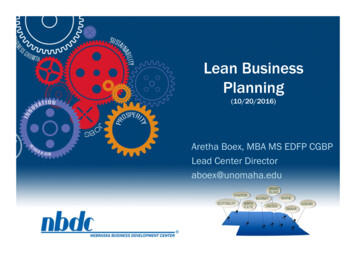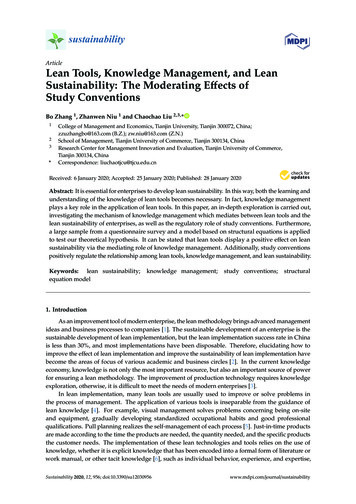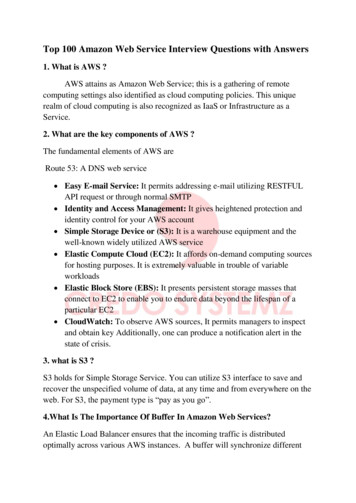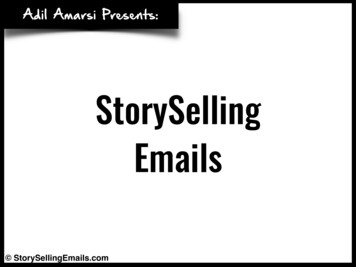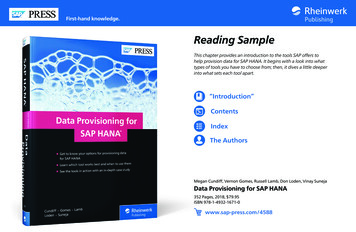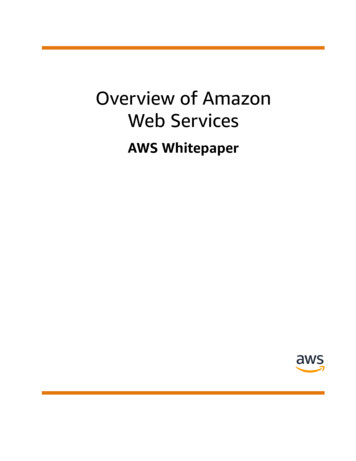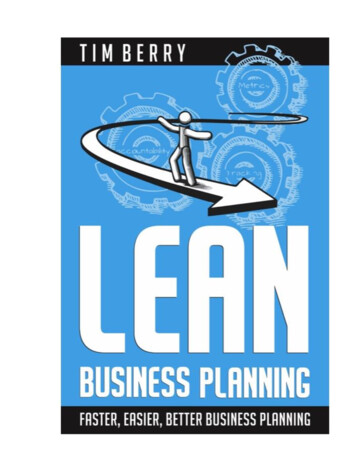
Transcription
1
LEAN BUSINESS PLANNINGWith LivePlanByTim BerryCopyright Timothy John Berry, 2015-2018All rights reserved. Distributed for free by Palo Alto Software with permission of the author.2
About the AuthorTim Berry is the best-known and most-respected expert on business planning in the world. Do aGoogle search for “business plan expert” and you’ll find Tim Berry listed first in the organic, unpaidresults. Business writers have called him “the business plan guru” and “the Obi-wan Kenobi of businessplanning,” in print, in major media.Berry founded Palo Alto Software and built it on his own, without outside investment, to multimillion-dollar sales, profits, and cash flow independence. He’s a leader in a local group of angel investors.He did business planning for Borland International, a software company that went public in less than fouryears; for various divisions of Apple Computer for 12 years; and for a collection of clients, large andsmall for decades. He’s the author of The Plan as You Go Business Plan, published by EntrepreneurPress, and half a dozen other books published by Entrepreneur, McGraw-Hill, Dow Jones-Irwin, andothers. Entrepreneur-celebrity Guy Kawasaki chose to interview Berry as his expert on business planning,and he’s been writing on that topic for more than a decade at Entrepreneur, SBA.gov, and other majormedia.He has a Stanford MBA degree, an MA in Journalism with honors from the University of Oregon,and a BA magna cum laude from the University of Notre Dame.There’s more information about him at timberry.com.3
Why Lean Planning“The plan is useless. But planning is essential.” Dwight D. EisenhowerWhat do you want from your business? Wealth? Fame? A better living? Maybe you want moreindependence or time off to coach your kids’ soccer team. With this book I’m going to help you get whatyou want. I will show you how focus, set priorities and expectations, and track results to help you getwhat you want from your business. I promise.Don’t sweat the big business plan. Skip the descriptions and explanations. Just do a lean plan. It willhelp you get where you are going without bogging you down. It’s fast, easy, and practical.Who doesn’t like planning a vacation? You decide where you’re going to go, look at the activities,attractions, restaurants, hotels, and the route. When I was a kid, we’d get together before our bigbackpacking trips and plan routes, food, and what to pack. As an adult, I join my wife in planning ourfamily vacations. Planning is part of the fun.And planning your own business? That’s fun too. Set your strategy and the tactics to execute it.Figure out pricing, marketing, and product. Dream and tell stories, and then add what it takes to makethem come true. It’s making things happen. It’s going from a vague, daunting, hard-to-manage uncertaintyto specific educated guesses, linked together, so you can address them. Get things done.4
This is the LivePlan-Specific version“LivePlan has reinvented business planning. It's the only tool that helps entrepreneurs track their progress witha unique dashboard specifically designed for small business.” John JantschThis is a special version of this book, tailored for use with LivePlan, the online tool for planning,tracking, and managing a small business, developed by Palo Alto Software. LivePlan is an excellentplatform for your lean planning. I’m founder and chairman of Palo Alto Software and I’m proud ofLivePlan and how well it works with my vision of lean business planning.LivePlan is ideal for doing your lean business plan. Use its pitch page as a strategy summary. Use itseasily modifiable outline to manage your lists of tactics and concrete specifics. Live Plan simplifies thefinancials to give you both easy, guided inputs, and outputs that automatically interpret your assumptionsto create formal financial projections and estimate cash flow.If you don’t already have an account at LivePlan, you can sign up at www.liveplan.com. And if youwould like the main (generic) version, it is available for sale in bookstores, at amazon.com, andelsewhere. You can find more information about that book at leanplan.com.5
One-Page SummaryAbout Lean PlanningLean business is a better way to do anything in business. Take small steps, look back, track results,see what works, and change often. Lean business planning is a way to optimize your business with focus,specific steps, tracking results, and changing quickly. The principles of lean business planning are to doonly what you need, track and review often, expect change, develop accountability, and remember it’splanning, not accounting.Do a Lean Business PlanSection 2, Lean Business Planning Step by Step, is all about how to do a lean business plan. First youdefine your strategy, such as focus on specific target markets and business offerings to match. Thenyou set execution, such as pricing, messaging, and location, to execute strategy. Then youdevelop concrete specifics, including dates and deadlines. And you also do the essential businessnumbers, including sales forecast, expense budget, and cash flow.Then Track, Review, Revise, ManageThe point isn’t the plan, but the business you get from it. Do the plan and then adopt an ongoingprocess of run-review-revise-repeat. When do you revise? When do you stay the course? That’s in Section3, Keeping it Live.AppendicesAppendix A shows how to calculate starting costs. Appendix B covers sharing your plan withsummaries, doing your business pitch, and doing an elevator speech. Appendix C is about planning forangel investment. Appendix D includes a complete sample lean business plan. Appendix E is a secondcomplete sample lean business plan.6
Section 1: FundamentalsNote: Do you like to just dig in? Skip the fundamentals and background. Just skipto Section 2 to just get going.You may have heard of the lean startup movement, or lean manufacturing. Thisis lean business planning. It gives you planning so you can follow up with tracking,management, and course corrections, to get the benefits of accountability, havestrategies and tactics aligned with specifics, and manage your cash flow. But it alsosaves you from the drawbacks of the traditional formal business plan document, whichis obsolete. It’s easier, faster, and better. Plan with lean bullet point summaries, a fewlists and tables, just the essentials that you need to achieve your business goals.7
Chapter 1: Lean Business“Lean manufacturing, Lean Enterprise, or lean production, often simply, ‘lean,’ is a productionphilosophy that considers the expenditure of resources in any aspect other than the direct creationof value for the end customer to be wasteful, and thus a target for elimination.” WikipediaIn general, lean means strong with muscle but no fat. Lean means useful. No frills. It’s not thin, notskinny, just lean.Lean ManufacturingThe concept lean manufacturing started with the Japanese automaker Toyota more than 70 years agoand was adopted by manufacturers worldwide. It focuses only on what adds value. And that avoids waste.Early on, the lean manufacturing people adopted a four-step process called PDCA, for plan-do-checkadjust. PDCA came from quality control expert Dr. Edwards Deming. PDCA itself (the idea of the cycle,although the acronym PDCA has various versions) became the gold standard for manufacturingefficiency.8
The essential idea is to take small steps, analyze often, and keep watching results and correcting.That’s instead of developing big elaborate plans first, then executing in big steps. There’s more review,more revision. That’s what is called lean.The benefits are obvious. Consider how the pace of change is constantly increasing. Technologyadvances faster every year. Adopting a lean process seems like common sense to me.My business experience has been mainly computers and software, but my formal education wasliterature first, then journalism, and then business. I learned software by doing. And, I confess, I never hadthe patience for the big software development plan that some of the larger companies and more schooleddevelopers did. I was the kind of entrepreneur who built the product in a way that got it to market asquickly as possible. There were always new versions to come. I never thought it was finished, and Iworked with the next steps and a broad larger vision. I moved in the right direction without taking a longtime trying to imagine, in detail, the final product. That was right for me. And it was lean by instinct,before I knew anybody called that lean.Lean StartupsEric Ries’ book The Lean Startup first appeared in 2011 and became the biggest thing in startups inthis century.What is it? It’s what the book says, but that’s a different book. For the purposes of definition in thisbook, here’s the Wikipedia definition:“Similar to the precepts of lean management, Ries' leanstartup philosophy seeks to eliminatewasteful practices and increase value producing practices during the product development phaseso that startups can have a better chance of success without requiring large amounts of outsidefunding, elaborate business plans, or the perfect product.” WikipediaThe emphasis there is mine. Keep this phrase “elaborate business plans” in mind when we move tothe next section, on the lean business plan.First, however, more about lean startups (continuing the Wikipedia text above):9
“This is done primarily through two processes, using key performance indicators and acontinuous deployment process. Because startups typically cannot afford to have their entireinvestment depend upon the success of one single product launch, Ries maintains that by releasinga minimum viable product that is not yet finalized, the company can then make use of customerfeedback to help further tailor their product to the specificneeds of its customers.” WikipediaThe lean startup applies the idea of continuous improvement in steps, or cycles, to starting a newbusiness. The lean startup begins with what they call a minimum viable product, then improves inrepetitive cycles, each one involving plan, action, checking results, and revising the plan to start again.The lean startup idea took off. Experts loved it. Both the lean startup and its suggestion of theminimum viable product now appear nearly everywhere that startups are discussed. There are steadilygrowing numbers of companion books, follow-up books, conferences, blogs, and lean startup experts andconsultants. Most serious attempts at funding new startups pay homage to the lean startup and minimumviable product.Is this a fad? No. I don’t think so. This is evolution related to real changes in the business landscape,accelerating technology, and world economies splitting into ever smaller and potentially more efficientpieces. And the fundamental idea is sound: plan more fluidly, take shorter steps, analyze results, and thentake more shorter steps. Change is constant, and the pace of change is increasing, so change the way youdo business. Make it lean. And that is as true for established businesses as it is for startups.10
Chapter 2: Why Lean Business Planning“However beautiful the strategy, you should occasionally look at the results.” Winston ChurchillSo we’ve seen in the previous section that using the term lean in business means focusing on whatadds value and avoids waste. It’s also about taking small steps and evaluating results often.It Starts with a Lean Business PlanLean business planning adopts the ideas of small steps, constant tracking, and frequent coursecorrections to planning. It includes only what adds value, without waste. It starts with a core business planfor internal use only, just big enough for optimizing the business. A lean business plan has four essentialparts:1. A strategy summary, which is a bare-bones description of strategy for management use only.2. Execution, also a bare-bones description, for management use only. It lays out tactics to executestrategy, like pricing, marketing, product or service development, financing, and so forth.3. Concrete specifics including review schedule, assumptions, milestones, tasks, and performancemetrics. Milestones include dates, deadlines, and budgets. Tasks include responsibility assignmentsand budgets.4. Essential forecasts including sales, spending, and cash flow. And, if you are starting a new business,also your starting costs.This lean plan is clearly not the “elaborate business plan” that lean startup experts reject. Unlike theelaborate plan, the lean plan doesn’t include carefully worded summaries or detailed business informationfor outsiders. It is not even a document. It’s a collection of lists, tables, and bullet points.11
Keep it Live. Use it Well.Just like lean manufacturing and lean startups, lean business planning is a process of continuousimprovement. It takes small steps, analyzes results, and makes corrections. I’ve revised the classic PCDAcycle to make a lean planning version that I now call PRRR, for plan-run-review-revise.So lean business planning is more than just the lean plan itself. It's the plan plus regular review andrevisions. You don’t ever finish it because if your plan is done, so is your business. Your live lean plan iseasy to revise, and you revise it as often as you want to.Add More Only as NeededMuch as the lean startup experts complain about what they call the elaborate business plan, realbusinesses, in the real world, do occasionally need to present a business plan to outsiders. They have whatI call business plan events, when a business plan is required.But times have changed. You still don’t need the big plan. Do your lean plan and keep it up to datewith regular review and revisions. And when somebody asks for a traditional business plan (if they do),then add the extra ingredients you need. That might be a market analysis, maybe an exit strategy, maybe adetailed description of product or marketing plan. Do them as summaries, presentations, or appendices.12
13
Chapter 3: Principles of Lean BusinessPlanning“It is not the strongest of the species that survive, not the most intelligent, but the one mostresponsive to change.” Charles DarwinThis chapter describes the principles of lean business planning. You might decide, as you read them,that they apply to all good business planning. I believe they do; but that’s up to you.1. Do Only What You’ll UseLean business means avoiding waste, doing only what has value. Therefore, the right form for yourbusiness plan is the form that best serves your business purpose. Furthermore, for the vast majority ofbusiness owners, the business purpose of planning is getting what you want from the business—settingstrategy and tactics, executing, reviewing results, and revising as needed. And that purpose is best servedwith lean planning that starts with a lean plan and continues with a planning process involving regularreview and revision. You keep it lean because that’s easier, better, and really all you’re going to use.Consider Illustration 3-1. I put the lean plan at the center because the plan is about what is supposedto happen, when, who does what, how much it costs, and how much money it generates. It’s a collectionof decisions, lists, and forecasts. It doesn’t necessarily exist as a single document somewhere. You use it14
to track performance against plan, review results, and revise regularly, so the plan is always up to date.Use LivePlan to keep all of this in one convenient place, where you can access it whenever you want to.And it’s only as big as you need for its business function.Illustration 3-1: Form Follows FunctionDon’t confuse the plan with the document, the summary, the slide deck, or elevator speech.The plan is what’s going to happen. The other forms are just output.The main output, and therefore the main purpose, of the lean business plan is better business, whichmeans getting what you want from your business. That’s what your lean plan is for and that functiondetermines what’s there. Forget the additional descriptions for outsiders until you need them. Wait for thatuntil you have what I call The Business Plan Event. One of the appendices, called Sharing Your Plan,covers how to do summaries, business pitches, and even an elevator speech.15
Know Your Market, Yes; Describe, Analyze, Prove—Not NecessarilyYou have to know your market extremely well to run your business. Know your market like youknow the back of your hand. Know your customers, what they need, what they want, how they find you,what messages work for them, what they read, what they do, and all of that.What you don’t have to do, however, is include any of that in your lean business plan. A lean plandoesn’t need rigorous market analysis. It doesn’t normally include supporting information — at least, notuntil later, with the business plan event, when it is actually required.However, your lean plan is about what’s going to happen, what you are going to do. It’s aboutbusiness strategy, specific milestones, dates, deadlines, forecasts of sales and expenses, and so forth. It’snot a term paper. Yes, you should know your market. But you don’t have to prove it until you’re trying tofind outside investors.Form follows function: The function of the lean business plan is getting whatyou want from your business, not selling something to outsiders.2. It’s a Continuous Process, not Just a PlanLean business planning isn’t about a plan that you do once. Just like lean manufacturing and leanstartups, it’s a process of continuous improvement.With lean planning, your business plan is always a fresh, current version. You never finish a businessplan, heave a sigh of relief, and congratulate yourself that you’ll never have to do that again. You don’tuse it once and throw it away. You don’t store it in a drawer to gather dust.However, this kind of regularly updated planning is clearly better for business than a more staticelaborate business plan. With lean planning, the plan is smaller and streamlined so you can update iteasily and often, at least once a month. Your lean plan is much more useful than a static plan because it isalways current, always being tracked and reviewed, frequently revised, and is a valuable tool formanaging. You run your business according to priorities. Your tactics match your strategy. Your specificbusiness activities match your tactics. And accountability is part of the process. People on the team areaware of the performance metrics, milestones, and progress or lack of it. Things get done.16
Furthermore, even back in the old days of the elaborate business plan, it was always true that a goodbusiness plan was never done. I’ve been pointing that out since the 1980s, in published books, magazinearticles, and blog posts. That’s not new with lean business planning. It’s just more important, and moreobvious, than ever before.So a business plan is not a single thing. It’s not something you can buy, or find pre-written. Youdon’t do it and forget it, and you don’t find a business plan or have one written for you. If you work withan expert, consultant, coach, or business plan writer, realize that in real use a business plan lasts only afew weeks before it needs to be reviewed and revised. So your value added from the expert has to helpyou in the long term. If you don’t know your plan intimately, then you don’t have a plan.3. It Assumes Constant ChangeOne of the strongest and most pervasive myths about planning is dead wrong: planning doesn’treduce flexibility. It builds flexibility. Lean business planning manages change. It is not threatened bychange. People say, “Why would I do a business plan? That just locks me in. It’s a straitjacket.” And Isay: wrong. Never do something just because it’s in the plan. There is no merit whatsoever in sticking to aplan just for the plan’s sake. You never plan to run yourself into a brick wall over and over.Instead, understand that the plan relates long term to short term, sales to costs and expenses and cashflow, marketing to sales, and lots of other interdependencies in the business. When things change—andthey always do—the plan helps you keep track of what affects what else, so you can adjust accordingly.Change does not undermine planning; actually,planning is the best way to manage change.So running a business right requires minding the details, but also watching the horizon. It’s a matterof keeping eyes up, looking at what’s happening on the field around you; and eyes down, dealing with theball—both at the same time.Which reminds me that dribbling is one of my favorite analogies for business planning. In soccer orbasketball, dribbling means managing the hand-eye or foot-eye coordination of the immediate detail whilesimultaneously looking up and watching opponents and teammates, and developing plays. When I was17
coaching kids in soccer, I’d try to help them remember to look up and not just down at the ball. The bestplayers did this naturally.Here are a couple of additional ways dribbling is like planning:1. Dribbling is a means to an end—not the goal. Planning is like that too. It’s about results, running abusiness—not at all about the plan itself. Good planning is measured by the decisions it causes.It’s about managing, allocating resources, and being accountable. I’ve written this in severalplaces: “You measure a business plan by the decisions it causes.” And this: “Good businessplanning is nine parts execution for every one part strategy.”2. Think of the moment when the player gets the ball in the wrong end of the court or field. That’seither a defensive rebound in basketball, or a missed shot on goal in soccer. The tall player gets thebasketball and gives it to the one who normally dribbles up court. Or the goalie gets the ball andgives it to a defender. At that moment, in a well-coached team: 1) there is a plan in place, and 2)the player knows the plan but is completely empowered to change it instantly, depending on howthe play develops. Business planning done right is very much like that. The existence of a plan—take the ball up the side, pass to the center—helps the team know what ought to happen. Butchanges—the opponents doing something unexpected—are also foreseen. The game plan doesn’tlock the players in to doing the wrong thing or failing to respond to developments. It helps themmake instant choices, changing the plan correctly and when they do, the other players can betterguess the next step because of the plan.4. It Empowers AccountabilityIt’s much easier to be friends with your coworkers than to manage them well. Every small-businessowner suffers the problem of management and accountability.Lean business planning sets clear expectations and then follows up on results. It compares resultswith expectations. People on a team are held accountable only if management actually does the work oftracking results and communicating them, after the fact, to those responsible.What gets measured is what gets done.18
Metrics are part of the problem. As a rule, we don’t develop the right metrics for people. Metricsaren’t right unless the people responsible understand them and believe in them. Will the measurementscheme show good and bad performances?Remember, people need metrics. People want metrics. You and your business need metrics.And so you have to track. That’s where the plan-as-you-go business plan creates a managementadvantage, because tracking and following up is part of its most important pieces. Set the reviewschedules in advance, make sure you have the right participants for the review, and then do it.In good teams, the negative feedback is in the metric. Nobody has to scold or lecture, because theteam participated in generating the plan and the team reviews it. Good performances make people proudand happy, and bad performances make people embarrassed. It happens automatically. It’s part of theplanning process. Besides, guilt and fear tactics are the worst kind of fake management.And you must avoid the crystal ball and chain. Sometimes—actually, often—metrics go sour becauseassumptions have changed. Unforeseen events happen. You manage these times collaboratively,separating the effort from the results. Your team members see that and they believe in the process, andthey’ll continue to contribute.5. It’s Planning Not AccountingOne of the most common errors in business planning is confusing planning with accounting. This istrue for lean planning too. Your projections, although they look like accounting statements, are justprojections. They are always going to be off one way or another, and their purpose isn’t guessing thefuture exactly right, but rather setting down expectations and connecting the links between spending andrevenue. Then when you do your monthly reviews, having made the original projection makesadjustments easier.They are two different dimensions.Accounting goes from today backward in time in exact detail. Planning, onthe other hand, goes forward into the future in ever-increasing summaryand aggregation.Understanding this difference helps you with the educated guessing involved in making projections.The reports that come out of accounting, called statements, must accurately summarize the actual19
transactions that happened in the past. For example, a proper and correct Profit and Loss statement inaccounting is a report summarizing all the actual transactions recorded as sales, costs, and expenses for aspecified period of time (month, quarter, or year).But projections, unlike financial statements, are just educated guesses. They aren’t reports of adatabase of actual transactions. Where accounting reports on records in a database, for projections there isno database. We guess what the totals might be.So you don’t try to imagine all the separate transactions in your head, for the future, and then reporton them. You estimate the totals. That’s not only easier, but better. It’s a better match to how theprojections help you manage, and how we humans deal with numbers.20
Section 2: Do A Lean Business PlanBenefits, definitions, and principles aside, this section takes you step by stepthrough the process of creating a lean business plan. It’s four steps: strategy, tactics,concrete specifics, and essential projections.Keep it simple. The lean plan is just what you’ll use. Yes, you should know yourmarket. Yes, you should have a marketing plan. But almost everything in your leanplan is lists or bullet points, for your own use only.21
Chapter 4: Set Your Strategy“The essence of strategy is choosing what not to do.” Michael PorterPull back from the keyboard. Put down that pen. Don’t write anything, please, until you’ve thoughtthrough your business strategy. Start your lean plan with practical strategy.It’s harder to write about strategy than just to do it. They give out PhD degrees for strategy studies,which can be extremely elaborate. People spend entire careers studying strategy as it applies to largecorporations.Strategy is like driving and sex—we all think we’re pretty good at it. But simplifying, doing todaywhat will seem obvious tomorrow, is genius. I say the best strategies seem obvious as soon as youunderstand them. Furthermore, it seems to me that if they don’t seem obvious after the fact, they didn’twork.I chose the Michael Porter quote above because I believe it’s a great way to see strategy in real worldsmall business and startups. Strategy is what you’re not doing. My favorite metaphor is the sculptor with ablock of marble—the art is what he chips off the block, not what he leaves in. Michelangelo started with abig chunk of marble and chipped pieces off of it until it was his David. Strategy is focus.22
Strategy is Focus.There is a very real business use for a strategy summary as part of every business plan, even a leanplan. Since strategy is focus, it leads to some difficult decisions as time goes on. New opportunities arise.Some new opportunities are great additions, offering healthy evolution and growth. Others are dangerousdistractions that dilute the business, blur the focus, and bring the business down. The owner, owners, orcore management team have to make these decisions, and they are hard. Normal entrepreneurs want to gointo every new market in order to please everybody they can. So a good strategy summary helps to framethe new opportunities.There’s no obvious formula for making these decisions. They don’t teach it in business school. It’ssomething business owners have to do for themselves. There is always risk and opportunity. So you referto your strategy summary first, and then think about it.This should come up in the monthly review sessions I recommend for every lean business planningprocess for every business.Strategy has to be easy to define. The LivePlan method’s Problem-Solution-Market-Why-Us worksjust fine for me. But I’ve also worked in depth, during my consulting years, with several competingstrategy frameworks, and every one of them works well if it’s applied correctly and executed. In fact, Isay you can also define strategy with a story, or a small collection of stories, which I explain in Lead withStories.And let’s be clear about this: Methods don’t matter. It’s what you focus on, and you need to remindyourself to execute consistently and over a long time. Use the LivePlan method here, or use stories, orsome other method. What matters is focus, what you do and don’t do, and whether it works.The LivePlan Lean Strategy MethodThink of it as the heart of the business, like the heart of the artichoke: it’s a group of four coreconcepts that can’t be separated: Problem, Solution, Market, and Identity. Don’t pull them apart. It’s theinterrelationship between them that drives your business. Each affects the other three.23
The Problem You SolveWe forget this too often: Your business is not about you, what you like to do, or what you want fromit. It’s about your customers. And, most important, the problem you solve for yo
The lean startup idea took off. Experts loved it. Both the lean startup and its suggestion of the minimum viable product now appear nearly everywhere that startups are discussed. There are steadily growing numbers of companion books, follow-up books, conferences, blogs, a
